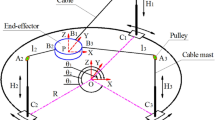Abstract
In order to solve the problem of ignoring the cable and only planning the trajectory of the lifted object and the robot ends, a planning scheme of a multi-robot collaborative towing system aiming at the cable obstacle avoidance motion planning was proposed. The univariate polynomial equation group of the cable was obtained by constructing the cable sweep equation and defining the implicit equation of the obstacle. Then, the point-to-point decomposition trajectory was planned for the initial trajectory of the lifted object in the variable cable length workspace. And the differential manifold and manifold tangent space theories were used to plan the predicted trajectory of the lifted object. Based on the system dynamics characteristics, the tangent vector selection of the predicted trajectory was determined. Finally, the three-level planning strategy with the lifted object as the planning object, the end of robot as the planning intermediate, and the cable obstacle avoidance as the planning purpose was finally realized.
Similar content being viewed by others
References
A. Ming and T. Higuchi, Study on multiple degree of freedom positioning mechanisms using wires (part 1): concept, design and control, International Journal of the Japan Society for Precision Engineering, 28 (2) (1994) 131–138.
D. Q. Nguyen and M. Gouttefarde, On the improvement of cable collision detection algorithms, Cable-Driven Parallel Robots, Springer, Cham (2015) 29–40.
Y. Su and Y. Y. Qiu, Derivation of Complete interference conditions for wire-driven parallel robots, Journal of Mechanical Engineering, 47 (15) (2014) 44–51.
Z. Wang, Y. Li and K. Shuai, Multi-objective trajectory planning method based on the improved elitist non-dominated sorting genetic algorithm, Chinese Journal of Mechanical Engineering, 35 (1) (2022) 1–15.
H. J. Wang, X. H. Ma and W. Y. Dai, Research on obstacle avoidance of mobile robot based on improved DWA algorithm, Computer Engineering and Applications (2022) 1–8.
T. Zhao, B. Zi and S. Qian, Algebraic method-based point-to-point trajectory planning of an under-constrained cable-suspended parallel robot with variable angle and height cable mast, Chinese Journal of Mechanical Engineering, 33 (1) (2020) 54.
A. Pott, Determination of the cable span and cable deflection of cable-driven parallel robots, Cable-Driven Parallel Robots, Springer, Cham (2018) 106–116.
P. Mcgarey, K. Mactavish and F. Pomerleau, The line leading the blind: towards nonvisual localization and mapping for tethered mobile robots, 2016 IEEE International Conference on Robotics and Automation (ICRA), IEEE (2016) 4799–4806.
D. Lau, O. Oetomo and S. K. Halgamuge, Wrench-cosure workspace generation for cable driven parallel manipulators using a hybrid analytical-numerical approach, Journal of Mechanical Design, 133 (7) (2011).
G. Abbasnejad, J. Eden and D. Lau, Generalized ray-based lattice generation and graph representation of wrench-closure workspace for arbitrary cable-driven robots, IEEE Transactions on Robotics, 35 (1) (2018) 147–161.
H. H. Cheng and D. Lau, Ray-based cable and obstacle interference-free workspace for cable-driven parallel robots, Mechanism and Machine Theory, 172 (2022) 104782.
Z. Qin, Z. Liu and Y. Liu, Workspace analysis and optimal design of dual cable-suspended robots for construction, Mechanism and Machine Theory, 171 (2022) 104763.
C. Su, J. N. Ye and W. Li, Analysis of dynamic workspace for under-constrained coordinate suspending system with multirobots, Journal of Shanghai Jiao Tong University, 53 (2) (2019) 225–231.
C. Su, J. H. Li and W. C. Ding, Static workspace analysis of a multi-robot collaborative towing system with floating base, International Journal of Modeling, Simulation, and Scientific Computing, 12 (2) (2021) 2150009.
Z. G. Zhao, F. J. Teng and G. T. Shi, Analysis and calculation of feasible region of multi-robot combined lifting system, Journal of Shanghai Jiao Tong University, 49 (8) (2015) 1174–1180.
Y. L. Wang, Z. G. Zhao and C. Su, Analysis of the workspace and dynamic stability of a multi-robot collaboratively towing system, Journal of Vibration and Shock, 36 (16) (2017) 44–50.
Z. G. Zhao, F. J. Teng and G. T. Shi, The inverse kinematics analysis of multi-robot combined lifting system, Journal of Harbin Engineering University, 37 (2) (2016) 254–260.
X. X. Liang, Z. G. Zhao and J. N. Ye, Trajectory tracking control of multi-robot parallel coordinated towing system, Computer Simulation, 35 (4) (2018) 295–300.
Z. G. Zhao, Y. L. Wang and J. S. Li, Appraise of dynamical stability of multi-robots cooperatively lifting system based on hybrid force-position-pose approach, Journal of Harbin Engineering University, 39 (1) (2018) 148–155.
Acknowledgments
The study was supported by the National Natural Science Foundation of China (Grant Nos. 51265021, 51965032) and Gansu Provincial Department of Education: Excellent Graduate Student “Innovation Star” Project (Grant No. 2022CXZX-571).
Author information
Authors and Affiliations
Corresponding author
Additional information
Tao Li, male, was born in Pingliang City, Gansu Province, China, and is Master’s degree student. His research field is under-constrained multi-robot collaborative towing system for cable obstacle avoidance motion planning.
Zhigang Zhao, male, was born in Qingyang City, Gansu Province, China. He received his Ph.D. in Mechanical Engineering from Shanghai Jiaotong University. His research areas are special robots, multi-robot systems, and complex system identification and modeling.
Rights and permissions
About this article
Cite this article
Li, T., Zhao, Z., Zhao, X. et al. Study of cable obstacle avoidance planning of a multi-robot collaborative towing system. J Mech Sci Technol 37, 3125–3139 (2023). https://doi.org/10.1007/s12206-023-0537-z
Received:
Revised:
Accepted:
Published:
Issue Date:
DOI: https://doi.org/10.1007/s12206-023-0537-z




